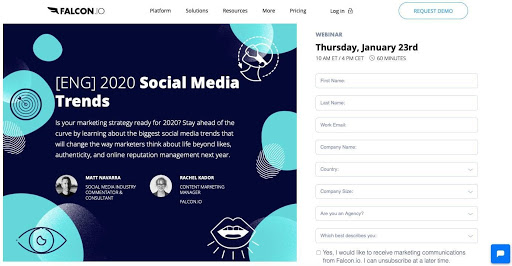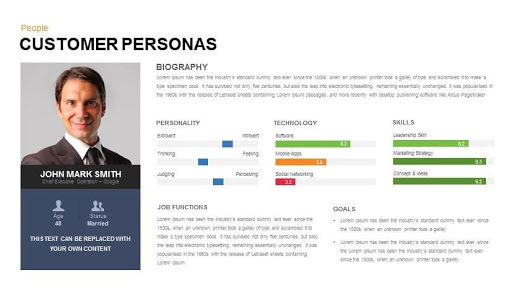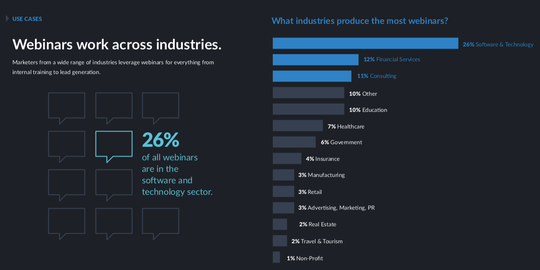How to Use Webinars to Scale Your Business During the Covid-19 Crisis
If you're a business owner, you might be facing tough times. As more and more people are staying at home due to the COVID-19 crisis, you're probably losing customers. You may even have been forced to indefinitely close your premises or pause trading.
But even if this is the case, there are things you can do to keep your business flourishing at this time. Thanks to the internet, you can continue to reach people wherever they are, generating leads and acquiring customers for your business.
In this article, I'll teach you how to use webinars to scale your business in the era of COVID-19. But first let's ask: why should we be using webinars?
Why Use Webinars?
Webinars are gaining enormous popularity among marketers and sales teams. According to Content Marketing Institute, 61% of marketers use webinars as part of their content marketing strategy. InsideSales says that 73% of sales leaders and B2B marketers believe webinars are a great way to generate leads, regardless of industry.
So what is so great about running a webinar? Well, rather obviously, webinars are:
- Convenient.
- Affordable.
- Effective.
With a webinar you can set up an event with hundreds of attendees, without ever leaving your home. An average webinar costs anywhere from $100 to $3000, depending on the amount and type of promotion involved. The cost of an event can range from $550-$75,000.
So it's clearly cheaper. But what about the conversion rate?
Webinars are one of the best marketing channels to generate leads. The best webinars Neil Patel was hosting were consistently converting at 22%. This is heads and shoulders above the 2-3% conversion rate you might get from a sales page.
How to Run a Webinar
So you're sold on the idea of webinars. Let's look at the steps you need to take to successfully run a webinar.
The first thing you'll need to do is pick a great topic. Your topic needs to be relevant to your audience and align with your services. For example, if you're selling a social media management platform, you might offer an informative webinar on social media trends of 2020. As well as giving you a platform to showcase what you offer, this also helps establish you as an authority in your niche.
This is what Falcon.io, which offers cloud-based social media marketing and customer experience management solutions, did. They picked a relevant topic for a webinar that aligned with their niche.

If you're stuck, one of the easiest ways to come up with a topic is to use Eventbrite. Do a Google search for "your niche + workshop + Eventbrite + big city." Take note of what events come up and how many attendees they have. Use this to inform your choice.
How to Prepare for Your Webinar
Your registration page is the entry point to your sales funnel. This is where your attendees will leave their contact information. Not everyone who registers will attend, as discussed above, but you still have their contact details either way (more later on how to use this.)
Your registration page, then, needs to compel people to sign up. At a minimum, it needs an attention-grabbing headline, a brief outline of the webinar content, and a "Register" button.
You can even add a limited-time bonus offer or a countdown timer to create a sense of urgency. Finally include a bio about the speaker. Your registration page should be simple. Be creative, but don't go overboard.
Generate Leads With Email Outreach
Since your goal is to make a sale, your webinar needs to be effectively targeted towards your potential market. If you're selling a social media management tool, for example, you probably want to target marketers and advertisers. Or if you're selling e-learning services, educators and school administrators will be your target audience.
This is where targeted email outreach comes in. Start by defining your ideal customer. This "customer persona" should cover the following at a minimum:
- Type of company they work for
- Position in the company
- Professional goals
- Personal objectives
- Problems that need fixing
Here's an example of what a customer persona template could look like.

Source: SlideBazaar
Once your target audience is clear, you can start looking for prospects.
You can do this using LinkedIn and email finding tools. Start by searching for companies through LinkedIn, then locate the relevant people in those companies. Now use an online tool to verify emails and find their email address, if they are not listed.
The invitation should be simple and to the point. It only needs to include the four Ws and one H: Who, What, When, Why and How.
As well as answering the five basic questions above, your invitation should create a sense of urgency and play on FOMO (Fear Of Missing Out.) Using humor in your email can also be effective if you do it well.
As well as email outreach, you should also promote your webinar on your website or blog, and on your social media accounts. Remember to use images and banners to grab attention.
Tips for Presenting Your Webinar
With a plan in place to promote your webinar, you're ready to go! Preparation is key in delivering a great webinar. Prepare your slides and notes in plenty of time, rehearse what you're going to say, and make sure you're using a suitable webinar platform.
Remain focused on your goal: to provide value to your attendees and to make a sale. To achieve these, follow this structure:
- First, gain your audience's trust. Introduce yourself, tell your story, and establish your credentials. The goal here is to reassure your attendees that you are a credible source of information.
- Then it's time to start delivering the content you promised. Don't be relentlessly serious - a well timed joke or two will keep your audience engaged.
- Give your audience a reason to stay until the end. You could offer a freebie, discount, or a draw for a door prize.
- Don't forget to leave time for a Q&A session. Attendees can email you questions ahead of time or put them in the chat box during the call.
- End your presentation with a call to action. Include the link to your squeeze page or sales page, as well as your contact information. You can also include a special offer here, such as a free consultation session or a discount code for your services.
That last point is vital. You need to send your warm leads somewhere if you want to make sales. You can use a landing page creator to design the sale page. Your sales page should outline your offer and then either get them to fill out a form or make an instant purchase.
How to Follow Up After a Webinar
If you want to maximize the effectiveness of your webinar, you must follow up. This is the time to engage warm leads and try to convert these leads into sales.
Send a "thank you" email to those who attended, and don't forget to reiterate the call to action. Think of this as another opportunity to sell your product or service. This is a great time to include an irresistible offer.
You should also send an email to those who registered but did not attend. This should include a link to your slides and, if you have one, a recording of the webinar.
Solicit feedback from all attendees. This will help you improve if you offer further webinars in the future.
Making the Most of this Opportunity
There's no denying the impact that the COVID-19 crisis has had, and will continue to have, on businesses. But thanks to technology, we're able to make adjustments and alter the way we work within this new reality. The global nature of the internet also allows us to reach a greater range of potential customers than ever before.
Webinars are one great tool for growing your business in this increasingly digital world. The evidence shows that they help generate leads and make conversions. With proper planning, the right tools and a little creativity, there's no reason you can't scale your business even in the midst of this ongoing pandemic.
This guest article was written by Owen Baker, a content marketer for Voila Norbert, an online email verification tool. He has spent most of the last decade working online for a range of marketing companies. When he's not busy writing, you can find him in the kitchen mastering new dishes.


